
Article contents

You’ll need more than you think in your pension pot for retirement. For the recommended minimum level of income you’ll need £88,958, and this rises to £881,719 for a comfortable retirement (plus you'll need the full State Pension). Don’t panic though, it’s achievable with the right savings plan over time.
Worried about how much you’ll have in your pension pot by the time you retire? Don’t worry, we all are. Pensions can be complicated, especially trying to work out how much you actually need to retire, but we’re here to help.
Here’s everything you need to know about how much to save for retirement. We’ll also cover the best way to boost your pension savings too.
As a quick spoiler, the best way to save more for your retirement is with a personal pension – you’ll get a massive 25% bonus on all of your contributions. If you’re not sure where to get started, here’s the best personal pensions (PensionBee¹ comes out top, highly recommended and is 5* rated).
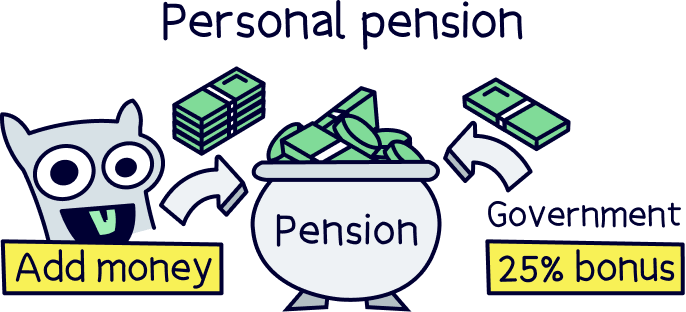
First, you’ll need to work out how much retirement income you realistically want and need to live on. Luckily, the hard work has already been done, and the nice guys at the Pensions and Lifetime Savings Association have put together the Retirement Living Standards. We’ve summarised this all below.
There’s 3 categories of retirement income that act as a great measure for how much you’ll need in retirement and how much you need to save to retire. There’s 3 categories – minimum, moderate and comfortable:
Here’s how much you’ll need per year for each retirement standard:
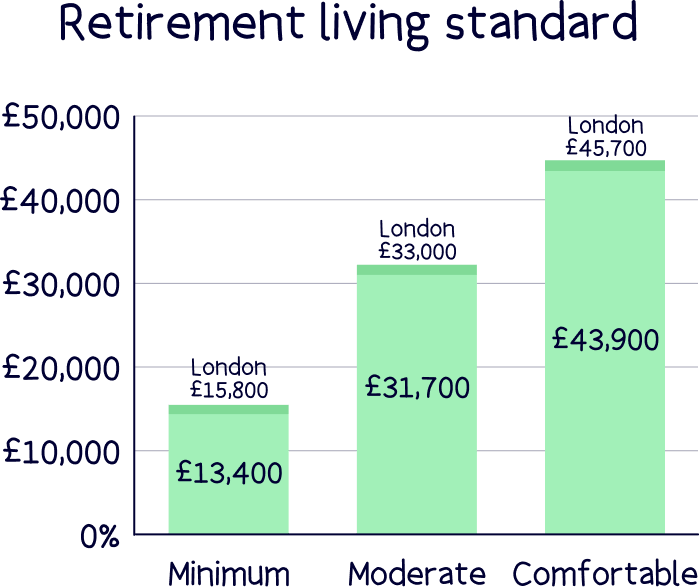
Is it more or less what you were expecting?
The important thing to point out here is that these figures don’t include any housing costs, so no rent or mortgage payments – it’s assumed that you have a mortgage and it’s been paid off by the time you retire. If you think you’ll have to pay rent or any mortgage payments, you’ll need to add these on top.
You’ll also need to add anything else that you might want to do, such as hobbies like golfing, or treating the grandkids to expensive presents, things like that.
The minimum annual income should be the absolute minimum you aim for. To put it in perspective, it’s nearly half as much as the current minimum wage. You’ll likely struggle with just this. We recommend aiming for as much as you possibly can, at least moderate and ideally towards comfortable.
So how much will you need in your pension to retire on the yearly income you want?..
So, how does that retirement income work out to a pension pot figure? The good thing is that the State Pension can boost your income significantly. We’ll cover the State Pension a bit more below, but just in case you’re not sure, it’s the pension you might get from the government when you reach State Pension age (currently 66).
That might seem like an impossible amount to save, but don't worry, we'll run through how to grow your pension pot shortly – you’ll be surprised by how big it can grow over time.
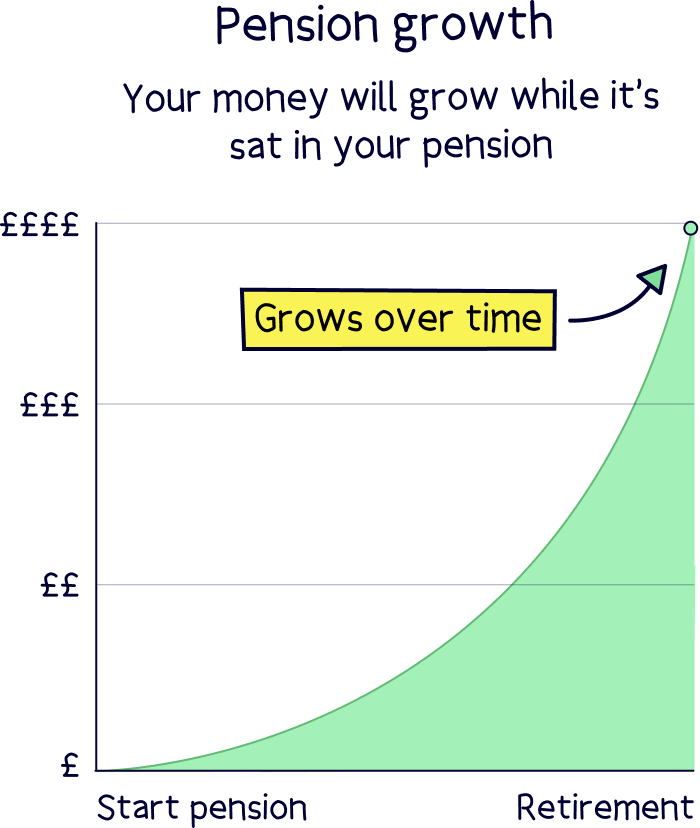
If you’re not quite sure what these numbers mean, here’s a quick explanation. To earn the minimum annual income of £13,400, you’ll need to save £88,958 into a private pension if you also receive the State Pension. We’ll cover what a private pension is below.
If you don’t intend to receive the State Pension, you’ll need a total private pension pot of £348,295 to get the minimum pension income level of £13,400.
Make sense? You can learn more about this with our guide to how much you need in your pension pot.
Boost your pension pot with a personal pension – and get a 25% bonus on all your contributions. Your future self will thank you.
So, how much do you actually need to pay into your pension each month to build up a pension pot to these levels?
We’ve worked it out for you, and broken down each retirement standard by age group – 25, 40, 50 and 60 years old.
We’re going to base your monthly repayments on the average pension pot for your age, so let’s quickly run through the average pension pot in the UK, and then after, how much you’ll need to save per month for the pension income you’d like.
The figures also include receiving the full State Pension when you retire.
Here’s the average pension pot in the UK – but don’t use this as a guide, it’s actually less than you need (most people aren’t saving enough for retirement).
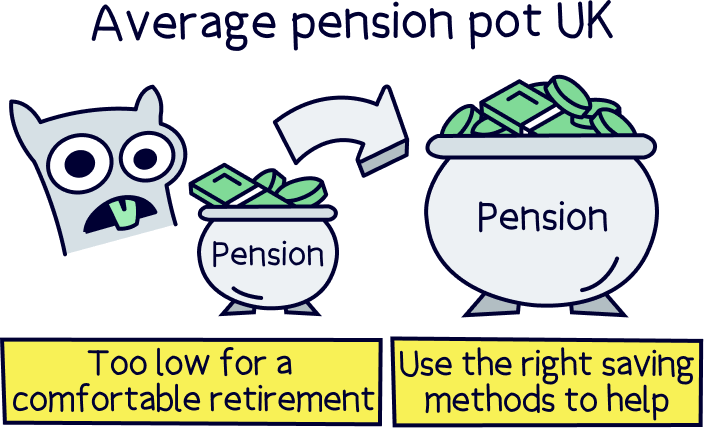
We’re using it as the base to estimate how much you might have in your pension pot now, in order to work out how much you should be paying in per month.
£88,958 in your pension pot for an income of £13,400 per year in retirement.
£564,615 in your pension pot for an income of £31,700 per year in retirement.
£881,719 in your pension pot for an income of £43,900 per year in retirement.
Confused? We hope it’s not too complicated, but let’s explain a bit more.
If you’re 25 and don’t have a pension pot currently, you’ll need to save £140 per month into your pension in order to build up a pension pot of £88,958 in total (in today's money), which, along with the State Pension, will provide the minimum retirement income of £13,400 (in today's money).
If you do have a pension pot near the average for a 25 year old (£2,700), you’ll only need to save £100 per month into your pension pot.
What you’ll see is already having a pension pot, even a small one, can have a big impact on how much you’ll need to save each month – although it’s difficult, it’s a great idea to save as much as you reasonably can now, rather than put it off to later down the line!
The best way to start saving is with a personal pension with a great provider, and we’ll cover what these are below. But, if you’re in a hurry, and not sure where to get started, here’s the best personal pensions.
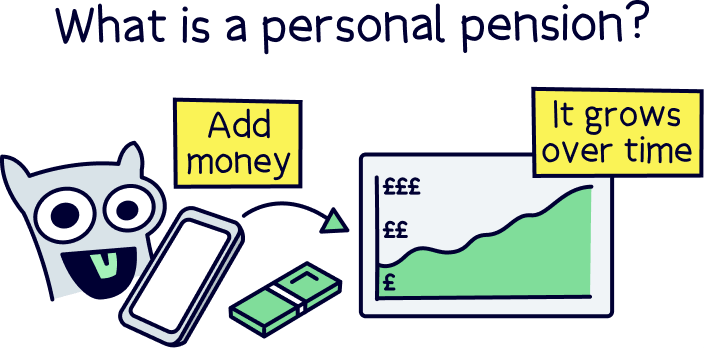
As a spoiler, PensionBee¹ comes out top, it’s 5* rated, has low fees and a great track record of growing pensions over time. Here’s our PensionBee review to learn more. There’s also Beach¹, which is great too, and offers a pension and ISA (for everyday savings) at the same time.
We’ve mentioned the State Pension and a private pension a few times, but if you’re not quite sure what they are, here’s an overview of both.
The State Pension is the government pension. You’ll get this if you make enough National Insurance contributions over your working career – at least 10 years worth, but 35 years to get the full amount.
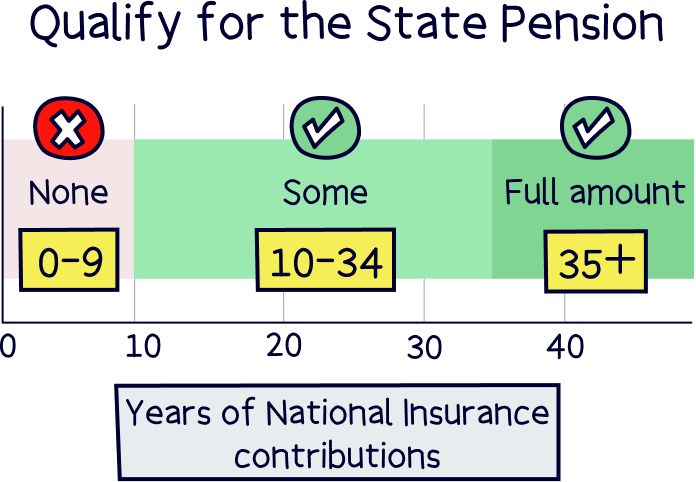
Currently, the full amount is £230.25 per week, which is £11,973 per year. It’s not a lot, which is why a private pension is highly recommended.
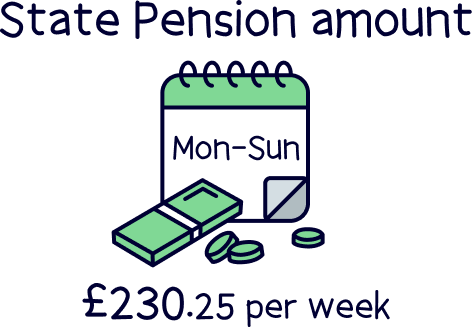
You’ll get the State Pension when you reach the official retirement age (State Pension age), which is currently 66, but rising to 67 in 2028 and in around 2039, it will be 68. Although you can continue to work and defer your State Pension, which will increase your weekly pension payments when you do decide to retire.
Let’s run through private pensions too – they’re pretty essential to building up a good pension pot and retirement income. The confusing thing is there’s a couple of types – a workplace pension and a personal pension.
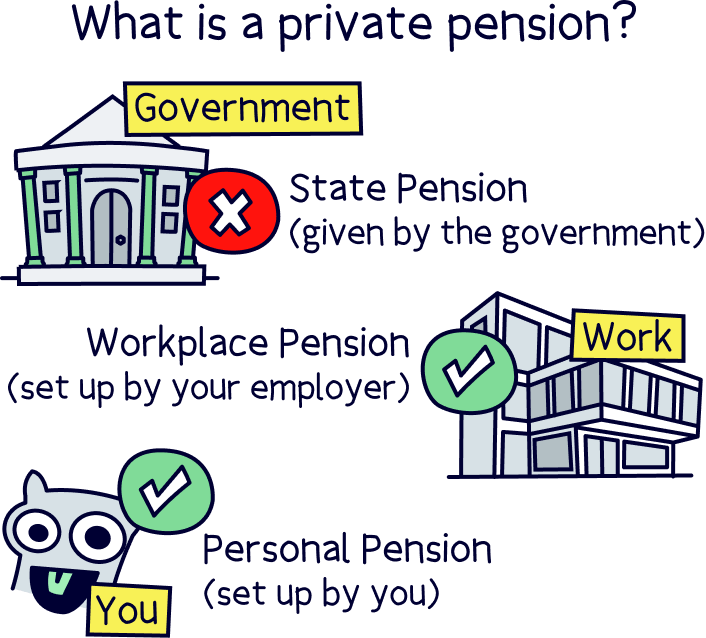
If you’re employed, you’ll likely have a workplace pension. It’s a pension that your employer will set up for you. The great thing about these is your employer has to contribute to your pension too (by law!).
If you contribute at least 5% per year of your salary, your employer must contribute at least 3%. It’s like a pay rise.
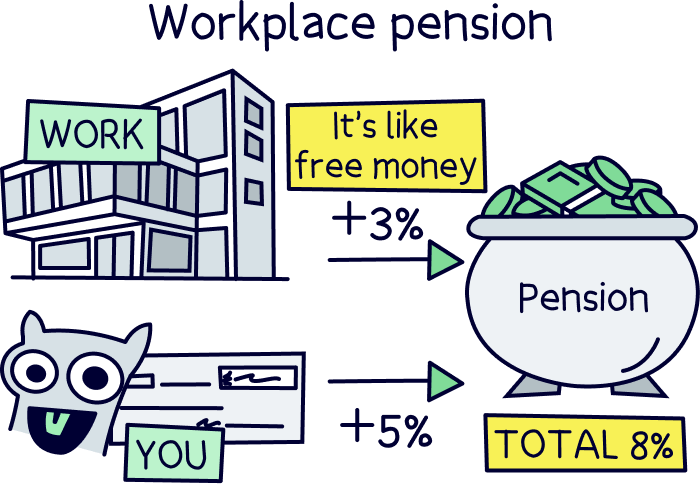
Plus, saving into them are completely tax-free – your contributions are taken out of your salary before you have to pay tax, which can make a real difference to your total pension pot over time.
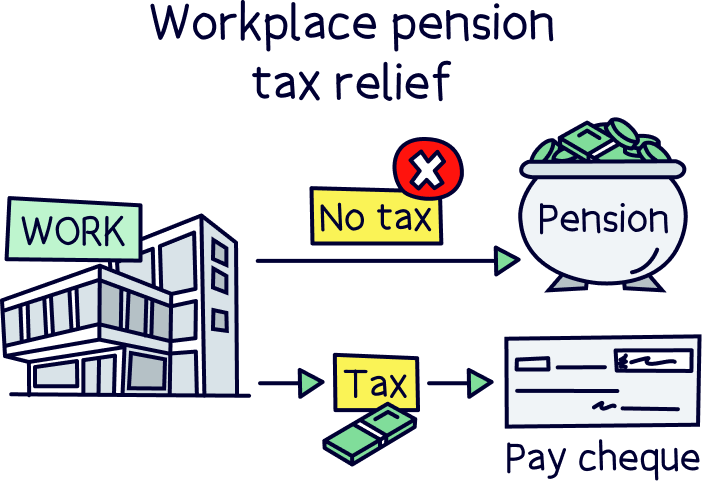
The only downside, is your employer chooses which pension company (provider) to use – and often, they just pick any old one to tick the box, rather than research the best one for their employees. This is where personal pensions come in.
A personal pension is one that you set up yourself (don’t worry it’s easy), and you decide how much you want to pay into it, and when to start withdrawing from it.
They’re a great addition to a workplace pension and can help build up a nice big pension pot.
If you’re self-employed, they’re your only option (but a great option). Check out our guide to self-employed pensions and contractor pensions to learn even more.
They’re also tax-free (you get tax-relief), except they work a bit differently to workplace pensions. As you’ll already have paid tax on your money, when you pay into a personal pension, you’ll actually be refunded the tax you’ve paid as a bonus straight into your account – and it’s a big bonus, 25% on your contributions!
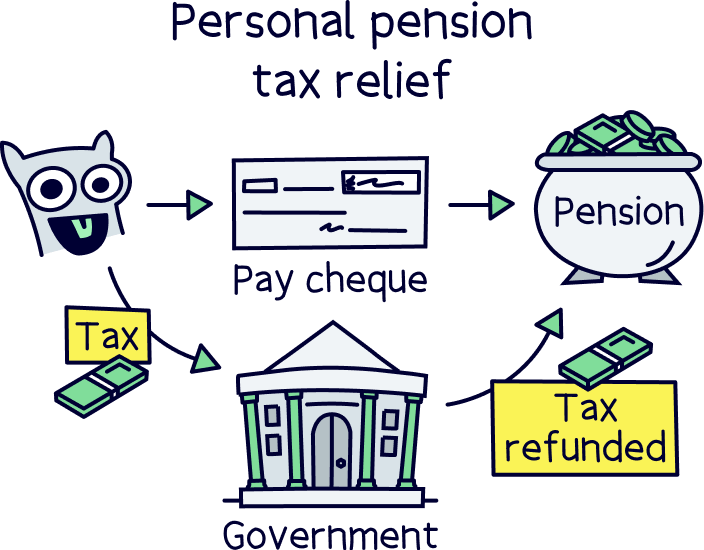
If you’re a higher rate taxpayer (40%), or additional rate taxpayer (45%), you’ll also be able to claim tax back that you’ve paid at those rates too (done on your Self Assessment tax return). The extra bonus can go a long way in helping you reach those high targets.
The best thing about personal pensions is that you get to pick which provider to use. That means you can pick a provider that’s easy to use, has low fees and a great track record of growing pensions over time.
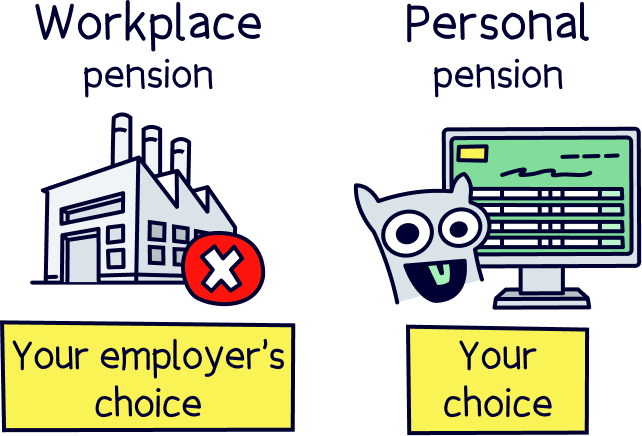
If that sounds good to you, check out PensionBee¹ – they’re all of the above and 5* rated. Beach¹ is also great, it's an easy to use pension with a great app. Add money or combine old pensions (and find lost pensions). Plus, the customer service is excellent.
Alternatively, compare all the best pension providers.
As you've seen, those pension pots need to be pretty big. But as we've said, don't panic just yet. Building up a nice big pension pot can be easier than you think over time. Here’s how.
Pension pots grow big by something called compound interest – that’s where the money your pension makes, makes money itself too, and this snowballs (compounds) over and over, and can turn small amounts into huge figures.
Let’s look at an example. Let’s say you have £500 in your pension, in a year, it has increased by 10% to £550, and you’ve made £50. In the following year, it also increased by 10%, but now your total balance has increased by £55, as you’re making 10% on £550, not £500. The following year it will increase by £60.50. This carries on over and over – and after a long period of time it can have a massive impact.
Let’s try a real world example. Say you are earning the average annual salary in the UK of £33,000, and have already saved a pension worth £10,000. If you have a workplace pension, you’ll be paying in 5% of your salary yourself, and your employer will be paying in 3%, so your pension contributions will be 8% per year, which is £220.
If your pension balance grows each year by 7%, after 25 years you would have a total pension pot of £235,470. Not bad right? And if you continue for another 10 years, you’ll have saved £511,294.
When your pension pot is this size, just one more year saving, you’d make £35,791 in one year – that’s more than your annual salary!
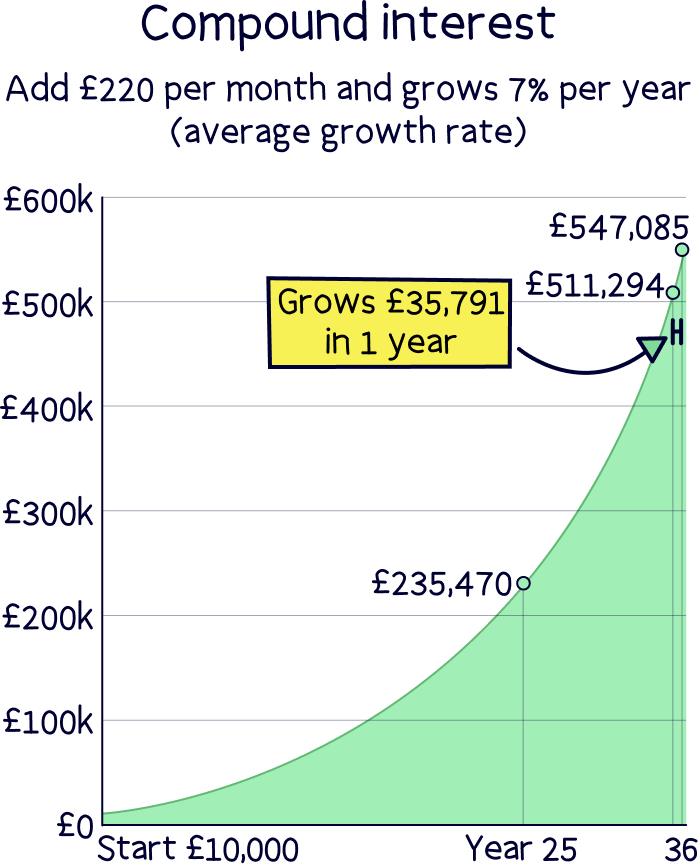
Can you now see how those large pension pots can be achieved? It’s easier than it seems, it just takes time. Although using the right pension and picking a great pension provider can make a real difference. We recommend using one of the best pension providers.
Note: your pension grows as your money is pooled together with lots of other people's money into what’s called a pension fund. And experts manage this pension fund to grow it in a safe and sensible way over time. However in the short-term the value of your pension can go down, but don't panic, pensions are for the long term.
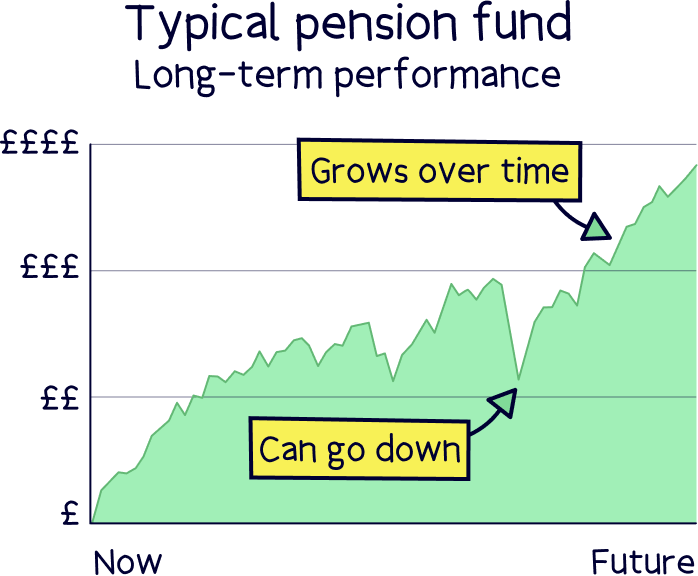
There’s 2 options to boost your pension pot, the first is to save more within a workplace pension (if you’re employed), and the second is to open a personal pension for yourself.
Saving more into a workplace pension than the minimum is only beneficial if your employer contributes more than 3% if you contribute more yourself (more than 5%). For instance, they could match your contributions if you paid in say 10%.
Nuts About Money tip: if they offer this, definitely take them up on their offer! You’ll be earning a lot of free money over the years – it’s just as good as a pay rise, maybe even better as it's tax-free!
However, often workplace pensions aren’t the best pension providers. Plus, you can’t transfer your current workplace pension while you’re still working there (transferring your pension is where you move it from one provider to another – you’d often do this to move to a better provider, for instance when you leave a company).
Enter the personal pension! You’ll still be able to save tax-free, as you’ll get a 25% bonus on your contributions. Plus, with a personal pension, you get to pick which provider to use, so you can pick one that’s easy to use, has low fees and a great track record of growing pensions over time. And you can transfer them to a new provider whenever you like!
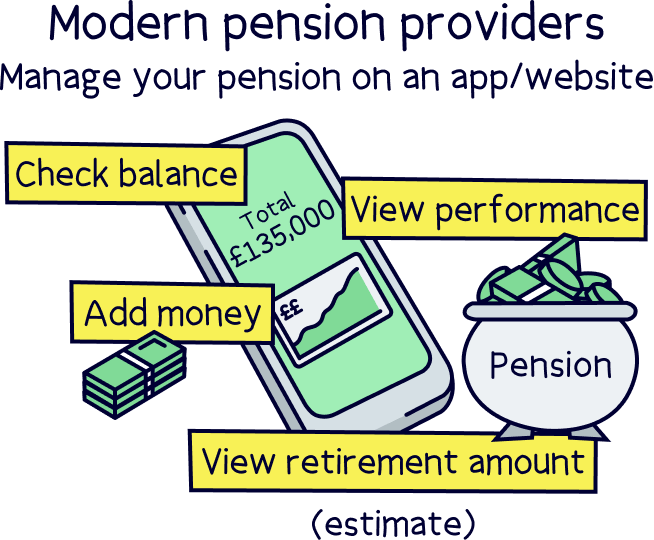
If you’re not sure how to go about finding these amazing pension providers, we’ve reviewed the best personal pensions, and the top are below:
Get £50 added to your pension



PensionBee is our recommended provider – they’ve thought of everything.
Their 5 star rated app (and website) makes it easy to set up and use. You can open a brand new pension, or transfer your existing pensions across (they’ll handle all the paperwork).
Simply pick from an easy to understand range of pension plans, and that’s it, the experts manage everything from there.
It’s low cost, with one simple annual fee. The customer service is excellent, and you’ll get a dedicated account manager for any questions you might have.

And, when the time comes to retire, withdrawing from your pension is easy too.
You can also use them if you're self-employed or a company director.
Great app



A great and easy to use pension. Add money from your bank or combine old pensions into one, (they’ll find lost pensions too).
The customer service is excellent, with support based in the UK.

Beach is an easy to use pension app (and easy to set up), where you just add money and the experts handle everything. It’s all managed on your phone with a great app, and you can see your total pension pot whenever you like.
If you’ve got lost or old pensions, Beach can also find them and move them over too, so you can keep all your retirement savings in one place, and never have to worry about losing them in future.
You’ll get an automatic 25% bonus on the money you add to your pension pot from your bank account (tax relief from the government), which refunds 20% tax on your income, and if you pay 40% or 45% tax, you’ll typically be able to claim the extra back too.
The pension plan (investments) are managed by experts, who are the largest investment company in the world (BlackRock). And they consider things like reducing climate change, meaning your savings could make the world a little better in future too.
You can also save and invest alongside your pension with an easy access pot (access money in around a week), designed for general savings, with the investments managed sensibly by experts too. And money made can be tax-free within an ISA.
Fees: a simple annual fee of up to 0.73% (minimum £3.99 per month).
Minimum deposit: £25
Customer service: excellent
Pros:
Cons:
Boost your pension pot with a personal pension – and get a 25% bonus on all your contributions. Your future self will thank you.
We’ve mentioned transferring your pensions to another better provider, and what this means is that you can consolidate all of your old pensions (if you have them) into your new pension. This simply means combining all your pensions together.
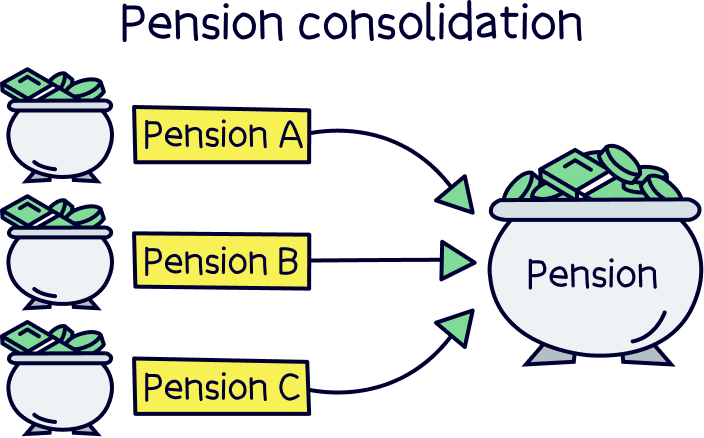
Why consolidate pensions? Good question. There’s a lot of benefits:
These are great benefits, and can really make a huge difference to your final pension pot – it’s worth keeping on top of where your pension is!
It’s super easy to consolidate your pensions too. All you need to do is let your new pension provider (such as the ones above) know where your old pensions are, and they’ll handle all the paperwork and transfer them across for you. It really is that easy!
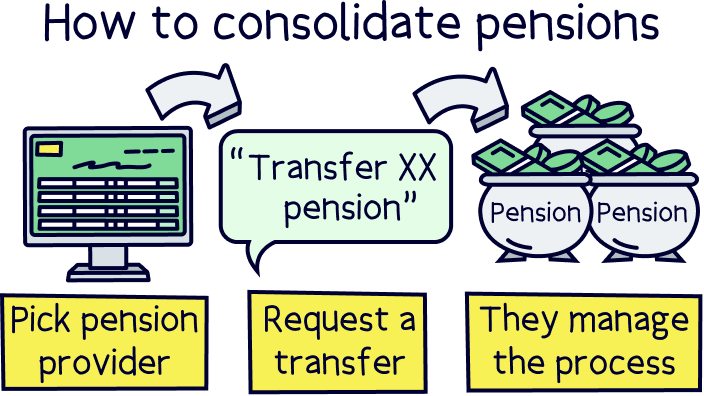
Before you get too carried away and put everything you have into your pension, there's a limit to be aware of.
You can’t put more than your total yearly income (e.g. salary) into your pension within a tax year (April 6th to April 5th the following year), or more than £60,000, whichever is lower. This is also called your annual allowance.
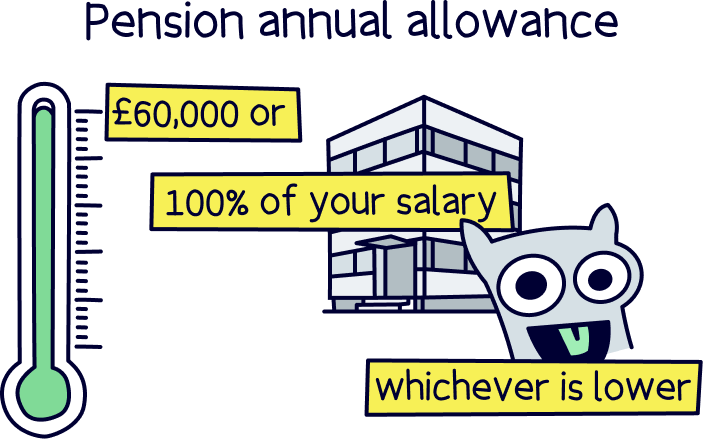
If you do want to save more, you could also save within a Stocks and Shares ISA. This is another tax-free savings account where you can invest up to £20,000 each year.
Once you’ve built up a nice big pension pot, hit your retirement savings goals, and are all ready to retire, what actually happens?
After you’ve turned 55 (57 from 2028), you can start withdrawing cash from your private pension (workplace and personal pensions) if you want to, although we recommend keeping it where it is for as long as possible, so it grows much bigger!
The first 25% of your pension will be tax-free, and you can take this as a tax-free lump sum if you want to. Otherwise, the first 25% of each withdrawal will be tax-free.
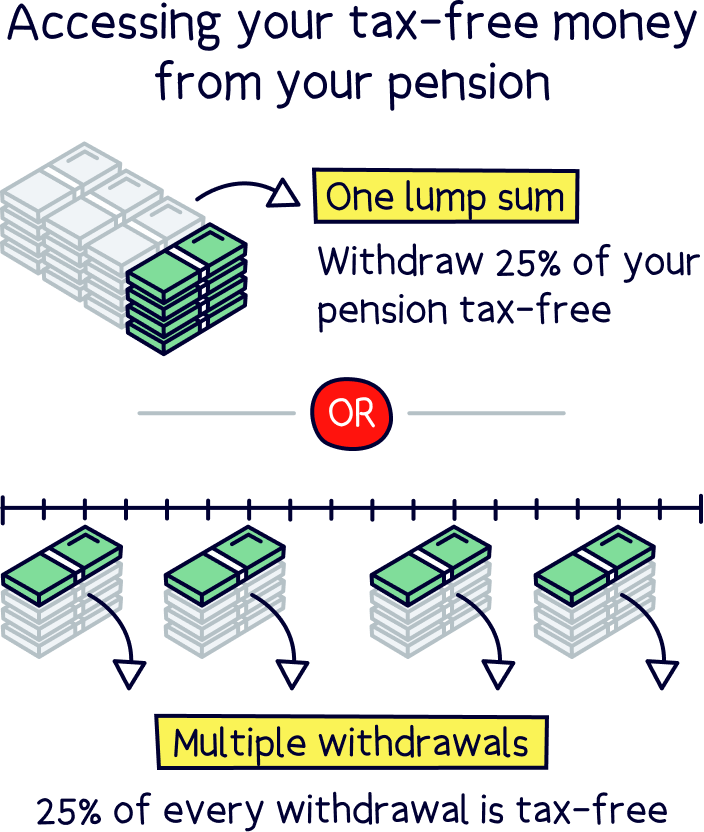
The remaining 75% will be liable for Income Tax, which is the same tax as your salary, and how much you’ll actually pay will depend on how much income you have at the time. You’ll still get a Personal Allowance of £12,570, before you’ll have to pay any tax.
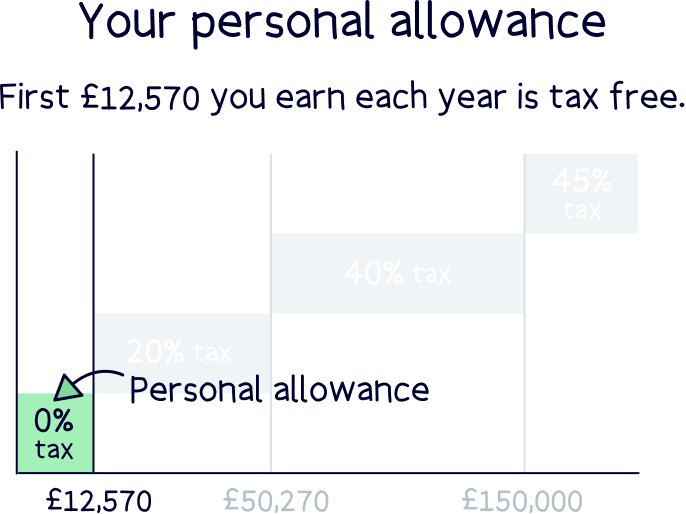
When taking your pension, you’ve got 2 options, you can either use your pension pot to buy an annuity, which is a guaranteed income each month for the rest of your life (or a set number of years). Or, you could simply leave your pension pot where it is, and withdraw cash as and when you need it (such as every month), which is called income drawdown.
Your pension provider will help you later down the line, but you could also get advice from an independent financial advisor. You can find great financial advisors with Unbiased¹.
If you’re eligible for the State Pension, you’ll also get this from age 66 (rising to 67 in 2028).
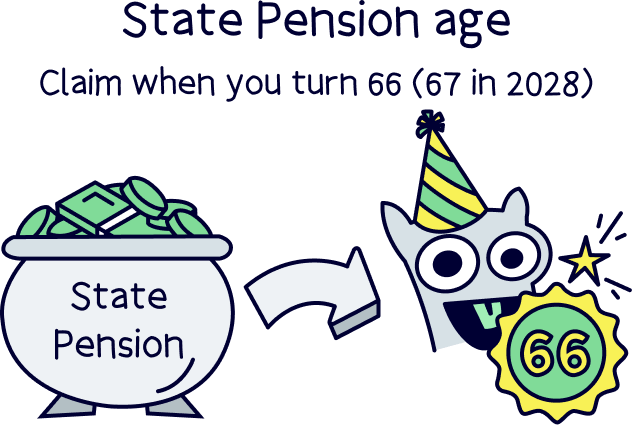
We hope that’s made saving for a pension a bit less daunting! How much money you need to retire is some seriously big numbers, as much as £881,719 in your private pension (and also get the State Pension), to earn a comfortable retirement lifestyle with an income of £43,900 per year.
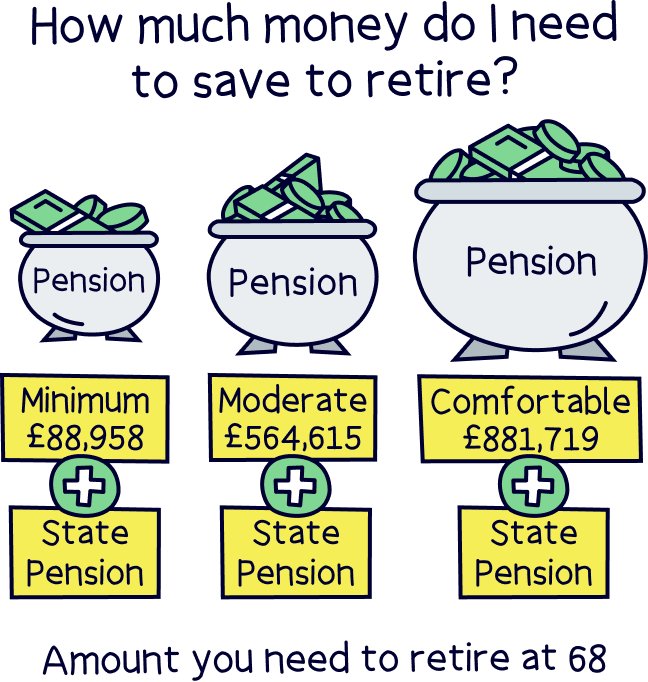
But don’t panic, you really can build a big pension pot over time – the longer you save the bigger it will get, and grow much bigger in later years. The key is to make regular contributions to your pension – and every little bit really does help!
How much you’ll need to save each month will depend on how much retirement income you think you’d need, but ultimately, save as much as you reasonably can to give yourself the best income possible.
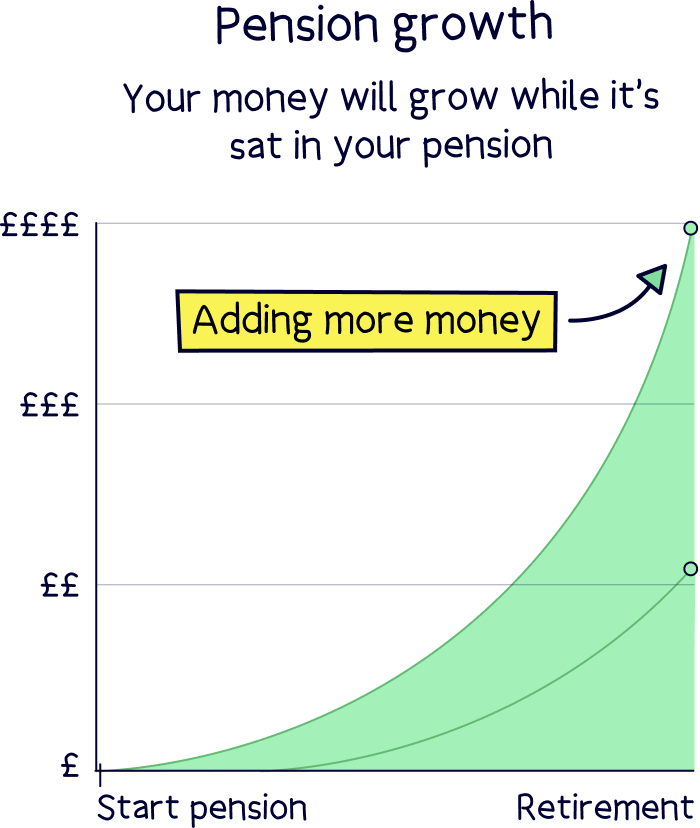
And the best way to save for retirement is through a personal pension, in addition to a workplace pension (if you’re employed) – you’ll automatically get a massive 25% government bonus on everything you pay in, and can pick a great pension provider, one that’s easy to use, has low fees, and a great track record of growing pensions over time.
If you’re not sure where to find these amazing pension providers, here’s the best personal pensions. To recap the top is PensionBee¹ – they’re all of the above and highly recommended. There’s also Beach¹ who can handle all of your savings, not just pensions.
And that’s all there is to it. Happy saving!
Boost your pension pot with a personal pension – and get a 25% bonus on all your contributions. Your future self will thank you.
Boost your pension pot with a personal pension – and get a 25% bonus on all your contributions. Your future self will thank you.
We’d love to hear from you, and it will help others too.
Boost your pension pot with a personal pension – and get a 25% bonus on all your contributions. Your future self will thank you.